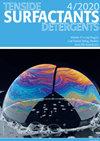Wetting behaviour of ionic surfactants on the aluminium foil
IF 1.2
4区 工程技术
Q4 CHEMISTRY, APPLIED
引用次数: 0
Abstract
Abstract Aluminium foil is a versatile material used in various industries, but its inherent low wettability limits its application. Surfactant can be used as effective agents for enhancing the wettability, enabling improved surface interactions and performance. In this study, we investigated the wettability of anionic (SDS and AOT) and cationic (CTAB) surfactants prepared in water as well as in isopropanol-water solvents with the four different volume fractions (0.1, 0.2, 0.3 and 0.4) on aluminium foil surfaces by measuring the contact angle. As the volume fraction of isopropanol on aluminium foil increases, the contact angle of SDS, CTAB, and AOT increases whereas the surface free energy decreases, indicating the hydrophobic nature of the surface. This trend is observed with the increasing concentrations of various solvents used. The adhesion work exhibits a linear increase with alcohol surface tension. A curvilinear variation is observed in the plots between cos离子表面活性剂在铝箔上的润湿行为
铝箔是一种用途广泛的材料,应用于各个行业,但其固有的低润湿性限制了其应用。表面活性剂可以作为增强润湿性的有效剂,改善表面相互作用和性能。本研究通过测量接触角,考察了制备的阴离子(SDS和AOT)和阳离子(CTAB)表面活性剂在水和异丙醇-水溶剂中(体积分数分别为0.1、0.2、0.3和0.4)对铝箔表面的润湿性。随着异丙醇在铝箔上的体积分数的增加,SDS、CTAB和AOT的接触角增大,而表面自由能减小,表明表面具有疏水性。随着所用各种溶剂浓度的增加,可以观察到这种趋势。附着力随乙醇表面张力呈线性增加。在cos θ $\theta $和1/ γ SL $\sqrt{{\gamma }_{\text{SL}}}$之间的图中观察到曲线变化。黏附功随接触角的变化曲线呈非线性变化。此外,cos θ $\theta $对乙醇表面张力和黏附功对log C的变化曲线。根据这些结果,本文旨在为表面活性剂在改善铝箔润湿性方面的应用提供有价值的见解。
本文章由计算机程序翻译,如有差异,请以英文原文为准。
求助全文
约1分钟内获得全文
求助全文
来源期刊

Tenside Surfactants Detergents
工程技术-工程:化工
CiteScore
1.90
自引率
10.00%
发文量
57
审稿时长
3.8 months
期刊介绍:
Tenside Surfactants Detergents offers the most recent results of research and development in all fields of surfactant chemistry, such as: synthesis, analysis, physicochemical properties, new types of surfactants, progress in production processes, application-related problems and environmental behavior. Since 1964 Tenside Surfactants Detergents offers strictly peer-reviewed, high-quality articles by renowned specialists around the world.
 求助内容:
求助内容: 应助结果提醒方式:
应助结果提醒方式:


